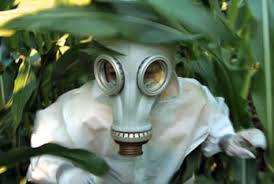Superbug genes are floating around in the air of 19 global cities, warn scientists … the next global pandemic is already in the making
08/02/2018 / By Vicki Batts

For many cities, air quality is a major public health concern — and new research has shown that it’s not just exhaust fumes people need to be worried about. For at least 19 global cities, genes from antibiotic resistant bacteria present a unique threat: The airborne antibiotic resistant genes (ARGs) could lead the way to serious and potentially lethal infections for millions of people. While antibiotic-resistant bacteria are already a major threat, the new research has confirmed that ARGs can be spread through the air — a finding that’s prompting even greater concerns for the future.
Antibiotic resistance is considered one of the biggest threats to global health, according to the World Health Organization. Overuse and misuse are some of the driving forces behind the rise of antibiotic-resistant bacteria. Some two million people are infected with antibiotic-resistant bacteria every year in the United States alone — and that number is expected to rise dramatically in the coming years. It’s estimated that antibiotic resistance will kill up to 10 million people annually by the year 2050.
Antibiotic-resistance is in the air
The new research, led by scientists from Peking University looked at the amount of ARGs in the air from 19 different cities scattered across the globe, and the American Chemical Society has confirmed that ARGs can be found in the air at parks and farms across the United States.
According to the findings from Peking University researchers, ARG air content varies from city to city. For example, San Francisco had the highest concentration of ARGs in the air of any city — while the air in Bejing was home to a much broader spectrum of ARGs.

Genes resistant to penicillin and similar antibiotics were found in the air across the board, as were genes resistant to quinolones — a class of drugs commonly used to treat urinary tract infections. In six cities, the air contained ARGs that were resistant to the last-resort treatment for MRSA, a type of staph infection that’s already resistant to most antibiotics.
The researchers said of their findings, “Remote regions even without using antibiotics could be exposed to the second hand ARGs, which are initially being developed in other regions but transported elsewhere.”
“This work highlights the threat of airborne transmission of ARGs and the need of redefining our current air quality standards in terms with public health in an urban city,” the team explained further.
The threat of superbugs continues to grow
One of the most frightening things about antibiotic resistance may just be this: Bacteria are capable of “sharing” their resistant genes — and as the new research from Peking University shows, it is possible for bacteria to acquire ARGs simply through the air. This is a huge risk, as it means previously treatable bacteria can easily become a major threat.
As The Alliance for the Prudent Use of Antibiotics explains, bacteria can become drug resistant in two ways: Through genetic mutation, or the acquisition of ARGs from another bacterium. Antibiotic resistance can then spread in a variety of ways:
Genetically, antibiotic resistance spreads through bacteria populations both “vertically,” when new generations inherit antibiotic resistance genes, and “horizontally,” when bacteria share or exchange sections of genetic material with other bacteria. Horizontal gene transfer can even occur between different bacterial species. Environmentally, antibiotic resistance spreads as bacteria themselves move from place to place; bacteria can travel via airplane, water and wind. People can pass the resistant bacteria to others; for example, by coughing or contact with unwashed hands.
To put it simply, antibiotic resistance can spread through a variety of pathways. This is highly concerning, given that bacteria are able to “share” ARGs, even with different bacterial species. Combine that with rampant overuse of antibiotics, in both humans and animals, and a major problem is on the horizon. The WHO has already warned of a “post-antibiotic” world, which may be downright apocalyptic in terms of disease. But, all hope is not lost: There are many natural “antibiotics” that target and kill pathogenic bacteria with ease. Natural medicine often prevails where Big Pharma fails, after all. You can learn about these natural remedies at AlternativeMedicine.news.
Sources for this article include:
Submit a correction >>
Tagged Under:
This article may contain statements that reflect the opinion of the author





















